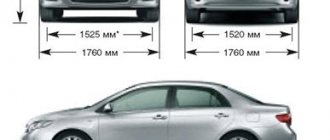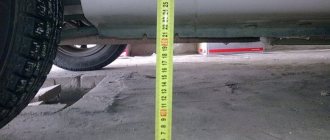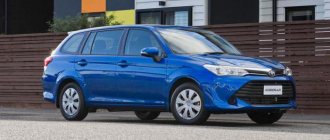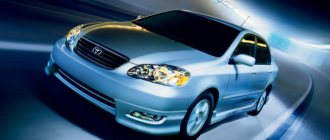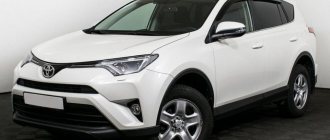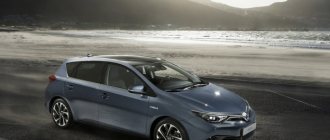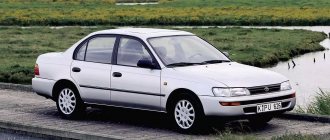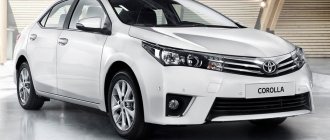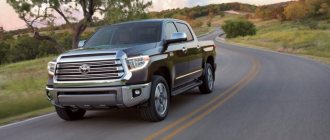One of the most popular Japanese models in the history of the automaker is releasing a new restyled version of the 2021 Toyota Corolla.
The main task of the engineers was to refine the model and combine in it all the most modern developments and all the best from previous models. If you look at the new Corolla, you can conclude that they succeeded.
The new 2021 Toyota Corolla began to look more modern and acquired pronounced features of a sports car. The front part, due to narrow headlights and a large bumper with a large air intake and PTF, began to look more aggressive. The radiator grille has become much smaller and narrower, and is separated by a chrome strip.
The company's chrome logo is still located in the central part . Headlights can optionally be either xenon or LED. There is a plastic protection installed at the bottom.
As for the side part, it began to look calmer, there is a relief along the entire body, and the handles are slightly recessed. The side mirrors have been completely redesigned. The glass became asymmetrical with a large number of fractures. The roof is slightly curved. The wheel arches look neater and feature new steel wheels. Due to the new optics and bumper, the rear part is very reminiscent of Lexus.
Historical information
The Corolla model appeared in the production program of the Japanese concern Toyota in 1966. For 18 years, the cars had a classic layout with rear-wheel drive and were supplied to foreign markets to a limited extent. In 1984, a new generation of E80 was introduced, which began to use front-wheel drive. The E90 generation began to actively promote foreign markets, and individual copies were delivered to the USSR. The next generations were distinguished by increased dimensions and increased safety; in 2018, E170 model cars were sold in Russia.
Toyota Corolla is one of the most popular Japanese cars.
Photos of the new Toyota Corolla 2021
Toyota Corolla 2018-2019
New Corolla hatchback
New generation Corolla
Toyota Corolla photo 2019
The interior of the Corolla has undergone even greater changes. There is practically no center console. The 8-inch monitor of the Entune 3.0 multimedia system has moved to the very top. Just below is the climate control unit and that’s it, there is no more functionality. The instrument panel will delight you with huge dials and cool blue backlighting. The chairs have changed their shape, the manufacturer promises incredible ergonomics and comfort. See photos of the salon below.
Exterior of Toyota Corolla 2018
The Corolla from the Japanese concern Toyota retains a massive front bumper with a central air intake and round fog lights (optional). Head optics with halogen lamps or LEDs contained daytime running lights. The inclined hood and streamlined sidewalls made it possible to reduce air flow resistance; the diffuser on the rear bumper of the Toyota Corolla reduced contamination of the trunk lid and lights, divided into asymmetrical sections.
Body
Since the entry into the Russian market of the 12th generation Corolla, presented in 2021 in the USA, was postponed for a year, dealers sold cars with the E170 generation body. The car had 4 doors and glass with a protective coating, which made it possible to maintain comfortable conditions in the cabin. Some modifications had LED optics installed at the front and rear, which was one of the competitive advantages.
Customers were offered Corolla cars in 9 color options; for the use of enamels with visual effects, an additional payment of 17 or 25 thousand rubles was provided.
Reimagined Appearance
After the classic profile of the 80s - 90s, starting with the 9th generation, Toyota Corolla changed the traditional proportions. The sedan looked sturdy, the outlines of the interior dominated the hood and trunk. Having worked on the 12th generation, the artists managed to return the squat swiftness of the 90s model. The proportions have not actually changed: upon closer inspection, it is obvious that similar body panels are used. However, several additional lines of side stampings, as well as new bumpers, visually stretched the body. New design alloy wheels 15 or 16 inches.
The facade has been completely transformed - there is virtually no radiator grille, and the air intake on the bumper dominates. The shape of the front end is based on refined touches from previous generations of Lexus. It was enough to remove the vertical edges at the corners of the bumper, and the car would be unrecognizable.
The narrow strip of the false radiator neatly transitions into rapidly slanting headlights. Traditionally, the lattice elements are continued in the optics body. Only in the new generation it doesn’t look so intrusive. The lower stripes of the daytime running lights, together with the small lenses of the headlights, give the “look” seriousness, if not aggressiveness. Low and high beam using LED technology.
The brand emblem does not fit into the width of the radiator grille and forms a traditional stamping in the bumper. Only in contrast to the playful “nose” of the 2000 model, this element looks neat and strict.
Car interior
The interior trim of the 2021 Toyota Corolla followed the design of the cars of the previous model year. On expensive versions of the car, an instrument cluster with a bright color display was offered. The multimedia center with a flat 7-inch screen allowed you to display images from the rear view camera. The Corolla's seats had fabric trim, the rear bench could be folded in a 40:60 ratio, and the front seats were manually adjustable. The Corolla was designed to carry 5 passengers, who could not complain about the lack of free space.
Technical specifications
Since the manufacturer actively published photos of the new generation Toyota Corolla, the development of the E170 generation stopped. The Toyota concern was little concerned about the sale of C-class cars in Russia, since the main profits came from Camry sedans, RAV4 crossovers and full-size Land Cruisers. Due to low popularity, the Auris hatchback was removed from the Russian market and a number of models for Europe were absent (for example, the compact Toyota Yaris or cars with a hybrid power plant).
The car interior is multifunctional.
Dimensions
The body of the Corolla remained unchanged; with a length of 4620 mm, the car had a width of 1775 mm, excluding the plastic housings of the rear-view mirrors. The 2700 mm wheelbase made it possible to increase the capacity of the passenger compartment, and the high roof of the Corolla preserved headroom for people sitting in the back row. Owners criticized Toyota Corolla cars for their long bumpers and 150 mm ground clearance, which made driving on rough roads difficult.
Engine and transmission
The base engine was a 1.33-liter Toyota engine with 99 hp. With. and was considered obsolete. The engine could only operate with a manual 6-speed gearbox equipped with synchronizers for forward gears. The line retains units with a capacity of 122 and 140 horsepower (the volume of 4-cylinder blocks is 1.6 and 1.8 liters, respectively).
Corolla engines were designed to use a CVT, but the 1.6-liter version was also available with a 6-speed manual transmission. Regardless of the type of power unit and gearbox, the front wheels were driving.
Fuel consumption
Efficiency of Toyota Corolla engines according to factory measurements:
- extra-urban cycle (at an average speed of 90 km/h) - from 4.7 to 5.3 l;
- in conditional urban mode - from 7.2 to 8.7 l;
- combined cycle - from 5.6 to 6.6 liters.
Suspension, brakes and wheels
The front suspension of the Toyota Corolla is an independent type with MacPherson struts and a stabilizer; the rear wheels are mounted on a torsion beam attached to the body through rubber hinges. Disc brakes, drives are divided into independent diagonal circuits. Corolla cars used steel wheels with protective and decorative caps or cast wheels (diameter 15 and 16″, respectively).
The carmaker's emblem has changed its location. Now it has occupied part of the bumper of the new car.
Eternal dream: test drive Toyota Corolla
Outside
In the penultimate generation of the Corolla of the period 2010-2013, the exterior design with sluggish and smooth features prevailed, according to modern sensations, “pensioner”.
Although, it should be noted, the public loved that old-school solid Corolla and still respects it very much in the secondary market. In the eleventh latest generation in the E160 body, the appearance of the Corolla instantly became “fashionable and youthful”, and the current restyling looks even more rapid, sporty, sharp and slightly daring. Although I’m not sure that the traditionalists from Toyota themselves like this “domestication”. The current Corolla combines the traditional nature of a classic sedan, for which the older generation loves it, and at the same time has many features that are attractive to young people: a catchy three-quarter poster look, headlights and taillights with slightly blade-like outlines, aggressive “gills” in the front bumper.
Chrome is used delicately in the trim and is an option. For example, in inexpensive options there will be no shiny metallic stripes on door handles. Actually, there may be more metal in the exterior - nice chrome moldings are optionally available, decorating the bottom of the doors that are somewhat empty without them, a spoiler tail painted in body color, and a number of other details. The shark fin antenna on the roof hides a GLONASS antenna for the panic button system, although navigation in Russia is still not offered for the Corolla.
1 / 6
2 / 6
3 / 6
4 / 6
5 / 6
6 / 6
Inside
Officially, the Corolla's interior is described as follows: “... the multi-layer architecture of the front panel, high-quality finishing materials, glossy lacquer and matte chrome accents create a harmonious premium style. Contrasting stitching and the multimedia system screen, made in the form of a modern tablet, confirm that you are driving a premium car...”
The authors of this text certainly went overboard with the “premium level”, although there are still interesting solutions. I’ll say this subjectively, of course, but in the interior of the Corolla I see some kind of not fully formed “fusion”, where the creators collected many different stylistic solutions, but in the end did not come to any single genre, but threw everything together. The same, say, side window blower deflectors - why are they round, what does this shape have in common? And the combination of several layers of elastic and hard plastics in the dashboard trim, coupled with stitching, looks like tuning, not the original. However, I don’t pretend to be true – it’s a matter of taste.
The restyled dashboard has changed slightly, but not significantly. It is easy to read and always in sight thanks to the height and reach adjustable steering wheel. For me, this is just right, but someone will rightly note that the tidy is too simple and does not fit well with the unusual multimedia panel in the cabin.
And the multimedia panel is implemented in a very, very interesting way! It differs from the banal and boring display of the pre-restyling version embedded flush into the dashboard in the spirit of traditional radio tape recorders, and from the oddly protruding “tablets” that are fashionable now. It seems that the Corolla display is “superimposed” on the dashboard by some separate, almost removable part. Its outlines in a metallic edging with two vertical rows of blue touch buttons evoke associations with serious home hi-fi. Looks great! (By the way, for owners of good collections of good old CDs there is a bonus - a disc drive)
By the way, about the sound... The front midbass are located in the doors, the tweeters are in the corners of the doors. The second pair of speakers is coaxial, in the rear shelf. Of course, there are no remote tweeters there. Despite the fact that the audio system is completely ordinary, according to the “if only it was” principle, the sound did not cause rejection, as happens with the sound of budget cars and those bordering them in price. No, it doesn’t have any particular bandwidth or power, but the tweeters in the corners of the front doors are well oriented and, apparently, even partially operate in the midrange, resulting in a certain feeling of immersion in the sound.
The climate panel (two-zone) has also been updated. Now it does not have the usual “knobs”, but controls the fan speed, air flow modes and temperature with keys that swing up and down. This solution requires getting used to and diverting the driver’s attention to manual adjustment.
The main advantage that someone who switches to a Corolla from a Solaris, Rio, Polo or even a modern VAZ gets is space for themselves and their family. For example, in comparison with the same budget sales hit from Hyundai, the Corolla is 22 centimeters longer, 7.5 centimeters wider, and the Japanese wheelbase is 10 centimeters longer. Behind the wheel of the Corolla, a person with a height of two meters and a weight of well over a hundred fits comfortably and completely freely. There is no excess headroom in the driver's seat, as in, say, a Superb or Passat, and you can't place a laptop on your lap while driving. But, in fact, the class is not the same, that’s normal. The space in front is solid, but without frills. Although a “luxury” in the form of electric seat adjustments would not hurt... But its absence is traditional for the Corolla.
At the same time, with the front seat completely moved back, a second, equally big guy fits quite comfortably behind the tall and hefty driver. And if you need to seat three people in the back, they will be comfortable not only with a high ceiling, but also with a practically non-existent floor tunnel, so that the average rider does not have to “keep their feet crossed.”
The rear seat is pushed all the way back. It can be seen that there is plenty of legroom for passengers. True, the only elements of additional comfort for the occupants of the sofa are the central armrest and a 12-volt socket for charging gadgets...
1 / 5
2 / 5
3 / 5
4 / 5
5 / 5
The trunk has a net volume of 452 liters. This is not too much; budget sedans often have 10-50 liters more. But the Coroll gives priority to rear-seat passengers over luggage, and that's probably right. Thanks to the independently foldable backrests of the rear sofa, the cargo volume can be increased if necessary. The only criticism is the false trunk floor, under which the spare wheel is hidden. It is made of the thinnest flimsy hardboard, close in density to box corrugated cardboard. Maybe this, of course, is not too critical for bags of grub from the supermarket, but it does not look respectable.
1 / 5
2 / 5
3 / 5
4 / 5
5 / 5
A specific design solution is to place under the ashtray cover the buttons for turning on the heated front seats, a USB slot and a 12 volt connector...
You just want to attach a telephone to the “canyon” formed by the door trim and glass: even a large gadget fits here perfectly. But this dubious life hack is only suitable for those who cannot stand dust and noise and never open windows.
What interesting equipment does the Corolla offer? In general, the chassis is sufficient even for rich trim levels of budget cars. Our equipment includes push-button start and keyless entry, a rain sensor, front and rear parking sensors with a camera, steering wheel adjustment in two positions, and dual-zone climate control. Four electric windows with one-touch lowering and raising (the auto function just appeared on the Restyle), electric folding mirrors, an auto-dimming element in the interior mirror (not in the exterior mirrors).
A little more interesting is the LED headlight (in the Style+ and Prestige versions), switching from high to low automatically, heated steering wheel and heated windshield wiper parking area.
True, the heating of the steering wheel is slightly disappointing due to its “zoning”: only the sectors at “10 and 14 o’clock” are heated, and the bottom and top of the “steering wheel” do not have heaters. But the stove is good! It quickly generates the first signs of warm air: an electric “dry hair dryer” is built-in. And when it gets hot, it gives out full heat, very powerful! The Corolla has one of the best heaters I've come across lately.
Regarding climate and heat, here’s something else I’d like to note... The heated steering wheel button is physical (that is, it has a fixed pressed/unpressed position), and so are the heated seat buttons. But the button for partially heating the windshield, for some inexplicable reason, does not have fixed positions. If the owner of a Corolla installs an alarm with remote start and leaves the car in winter, leaving the heated steering wheel and seats active, they will begin to heat up simultaneously with the engine starting, which is very convenient. But you will only have to turn on the heating of the wiper zone manually personally, when you have already gone down to the warmed up car and are ready to drive... In principle, this can probably be implemented with an additional channel, but installing the security system will become more complicated and more expensive.
Iron
The cost of a basic Corolla does not cross the psychologically important millionth threshold and starts at 954 thousand. But this exotic option is hardly worth considering, since it comes with a 1.3-liter engine and a manual transmission. Such a frail engine in a car that weighs three hundred tons can hardly be considered practical, especially when buying a car seriously and for a long time (otherwise what is the point of legendary Toyota reliability?) All subsequent options are equipped with 1.6-liter engines in both manual and manual versions. automatic boxes. With different options, they cost from 1,070,000 to 1,330,000. There is also the most expensive modification with a 1.8-liter engine (140 hp). All engines are of the Dual VVT-i line, naturally aspirated with phase regulators on the intake and exhaust. The optimal and most popular 1.6-liter engine produces 122 horsepower at 6,000 rpm and 157 Nm at 5,200 rpm.
1 / 3
2 / 3
3 / 3
There is hardly any need to be afraid of the CVT: in the case of the Corolla, it is combined with not very powerful engines, and the car’s weight is small. With timely oil changes and without trying to pretend to be a sports car pilot every minute, the Toyota “Varik” in most cases will not cause problems for the first owner in the first three to five years, and, most likely, the second one will drive it for the same amount of time with the typical 15 -20 thousand mileage per year. Although a classic hydraulic automatic transmission would probably be preferable for most Corolla fans...
1 / 2
2 / 2
In move
Power
122 hp
At first, the Corolla seems sluggishly vegetable. Yes, in fact, this is how it is with a 122 hp engine. and a variator... The engine perks up and gives traction only after 4-5 thousand revolutions, but the sport mode, the button of which is conveniently located near the gearbox selector for pressing blindly, partly corrects the situation, so you quickly get used to pressing this button. You can also control the variator manually by traditionally shifting the handle to manual mode. In principle, this brings a certain effect when overtaking and starting, but quickly gets boring. But in general, you still have to come to terms with the fact that with this engine, in terms of dynamics, you remain at the same level as with the previous Solaris, from which you planned to move to the next level of auto prestige by purchasing a Corolla.
The electric power steering feels a bit vague. There is feedback, but I would like a little more sharpness. A short throw to the side at speed in an attempt to avoid a small but deep pothole on the road may not be enough - the jerk is greatly smoothed out. At the same time, when driving in a straight line, the car on wide 205/55 R16 tires gives the driver a rest: it drives itself, as if on a thread.
The suspension proved to be both energy-intensive and composed. On a dirt road that looked like bubble wrap made entirely of ice hummocks the size of a fist and a half, the Corolla ran confidently at 50-60 km/h, making a dull splash of wheels and not bothering the riders. The rear suspension is a simple torsion beam, which somewhat affects the comfort of passengers: a good bump makes everyone aware of the soft spots, and not just the one on whose side it falls...
Test drives / Sedan Forget about the transmission: test drive of the new Toyota Corolla 11 Whatever you say, the Corolla is a truly unique case. Half a century without a name change, 37 million cars produced! Only on the roads of Russia they run in the amount of 685,000 pieces...... 17659 3 6 08/19/2016
I usually don’t say anything about brakes: frankly speaking, I haven’t come across a car for a long time where the designers made mistakes with the performance of the vacuum unit, the diameter of the calipers or other elements of the system, and the braking efficiency did not correspond to the weight or dynamics of the car. Of course, the brakes in the Corolla are also impeccable. But at first I had to get used to the unusual non-linearity of the pedal stroke: too much of the braking force is located in the first third of its stroke, and the initial shift of the pedal is a little tight. Because of this, the effect of excessive braking and systematic pecking occurs (especially at low speeds). However, after a couple of days I adjusted and stopped noticing this feature.
Model history
Toyota Corolla is the elder of the automotive world! The current generation is the eleventh in a row. The model was born back in 1966, and to date has sold almost forty-five million copies worldwide. The car was twice included in the Guinness Book of Records as a leader in sales and production volume. As of 2021, 685,000 Corollas, 671,000 Focuses, and 577,000 Logans were driving on Russian roads.
The first Corolla of 1966 was rear-wheel drive, with low-power 1.2-1.2 liter engines, but with automatic transmission in the range of transmissions. True, only dual-band. Sedan, coupe and station wagon body styles were offered.
1 / 3
2 / 3
3 / 3
In 1970, the second generation appeared. The car was still driven by the wheels of a solid rear axle, but the Corolla had grown slightly and received a 1.6 liter (115 hp) engine with a 3-speed automatic transmission.
Pictured: Toyota Corolla '1970–74
Generation number three was produced from 1974 to 1981 and did not receive any fundamental changes (there were only some improvements to the existing hardware). But the fourth generation was distinguished by many new technical solutions. First of all, in the field of body architecture, which affects safety in an accident. A diesel engine became available, and the rear suspension became independent. And it was in this generation that the millionth copy rolled off the assembly line.
| Pictured: Toyota Corolla '1974–79 | Pictured: Toyota Corolla '1979–83 |
The fifth Corolla was released in 1983, and its key feature was front-wheel drive. The sixth generation (1987–1992), like all subsequent ones, was front-wheel drive, and the dimensions again increased slightly. The seventh and eighth generations represented the evolution of well-known technical solutions and the expansion of the range of equipment, cementing the legendary reliability of the Corolla. Including victories in a number of the world's largest rallies. The ninth generation was produced from 2002 to 2007 and became the best-selling: the Corolla was produced by Toyota factories in 16 countries around the world! The range of transmissions was expanded with the addition of a “robot”, and for fans of hot hatchbacks there was a three-door T-Sport with a 192-horsepower engine.
1 / 5
2 / 5
3 / 5
4 / 5
5 / 5
The tenth generation started in 2006, celebrating the fortieth anniversary of the Corolla. The solidity of the model was increased by focusing on a sedan close to the Camry and separating the hatchback into a conditionally separate model - Auris. The current eleventh generation, characterized by a catchy modern design, is called the E160 and appeared in 2013. This generation experienced restyling at the end of 2021.
1 / 2
2 / 2
Security systems
The basic set of systems that ensured the safety of Corolla passengers included:
- inertial belts with tensioners for the front seats;
- pyrotechnic airbags for driver and passenger;
- anti-lock braking system with support for electronic brake force distribution and emergency stop assist;
- ISOFIX locks for securing child seats on the rear sofa of the Corolla;
- front head restraints made using WIL technology to reduce injuries to the cervical vertebrae.
On expensive versions of the 2021 Corolla, additional pillows were used, located along the upper edge of the doorways and in the backs of the seats. The standard ABS unit was supplemented with a system to prevent the car from skidding.
The electronics instantly monitored the beginning of the car's wheels slipping and automatically adjusted the power flow, and also prevented the Corolla from rolling back when starting to move down a slope.
Photos of the 2021 Toyota Corolla interior
Salon of the new generation Corolla
Photo of the Corolla 2018-2019 interior
Gearbox lever of the new Corolla
Chairs Toyota Corolla 2019
Options and prices
In the last year of production, Toyota Corolla E170 cars were offered to Russian buyers in 6 versions. The head optics retained the Coming Home track lighting function, and standard equipment included fabric floor mats for the driver and passengers. The manufacturer installed an ERA-GLONASS emergency communication unit (in accordance with the requirements of the legislation of the Russian Federation). The table shows prices for Corolla cars of the 2021 model year without taking into account dealer discounts.
| Model Corolla | Price, million rubles |
| Standard | 0,983 |
| Classic | 1,093-1,13 |
| Style | 1,143-1,18 |
| Comfort | 1,188-1,225 |
| Style Plus | 1,242-1,311 |
| Prestige | 1,329-1,361 |
Standard
The basic version is easily recognizable by its 15-inch stamped wheels and the absence of fog lights. The car was equipped with a 99-horsepower engine, and the cheap interior included a polyurethane steering wheel and a plastic plug for the radio socket. The Toyota manufacturer installed an air conditioner and an additional electric hair dryer in the instrument panel, which heated the air inside the car.
Inside, the car is trimmed with high-quality artificial leather.
Classic
Toyota's production line traditionally included a Classic modification with a 1.6-liter engine and poor interior trim. The car differed from the basic configuration in the cushions in the backs of the driver and passenger seats. The Standard and Classic steering wheels had buttons to control the operation of the on-board computer.
Style
The Style designation included the installation of 16-inch alloy wheels and round fog lights. Changes also affected the interior; the steering wheel had leather trim and electrically heated rims, and rear passengers could use electric window drives in the doors.
An additional feature of the car was its standard radio, capable of reading discs and decoding files recorded in MP3 format.
Comfort
The Comfort model featured rear LED headlights, but halogen headlights remained at the front. Rear passengers could use a folding armrest with cup holders, but the car's capacity in this case dropped to 4 people. The driver of a Toyota Corolla could read additional information from the display in the center of the instrument cluster, which had a 4.2″ diagonal. To protect passengers, there were curtain airbags, and hill start and anti-skid systems were used.
Style Plus
The modification boasted the installation of 1.6 or 1.8 liter engines and LED head optics. To increase comfort in the car interior, a 2-zone climate control system, a radio with an enlarged display and a function for displaying images from a rear view camera were used. The owner of a Corolla car could use electric heating of the lower part of the windshield of the car, which prevented ice from freezing on the brushes of the Toyota Corolla.
Prestige
The maximum option for equipping the car was distinguished by the use of keyless access to the interior and a button to control the ignition and starter. There were rain and ambient light sensors on the windshield, and the side mirrors could be folded, reducing the width of the Corolla when parked in a narrow driveway. An additional advantage of the car was the ultrasonic sensors in the Corolla's bumpers, which warned the driver of obstacles with a buzzer signal.
The front side of the car has undergone a complete transformation.
Salon
The interior of the new Toyota Corolla is a strong part of this car. It has an excellent combination of simple and expensive materials; in addition to leather, the interior contains high-quality fabric and ordinary plastic. The center console is located almost at a right angle, so the buttons located on it, except for those that regulate the climate control, are poorly visible. There is a 12-inch display that contains all the functionality, so you can control not only the entire multimedia system but also other settings from it.
The salon is quite large with high ceilings, despite the fact that from the outside the sedan seems small, so passengers inside this car will feel comfortable.
There are buttons with great functionality on the steering wheel . The instrument panel has large mechanical elements, between which there is a large on-board computer, thanks to which the driver receives all the necessary information.
The seats are quite comfortable with good lateral support and a wide range of settings. Therefore, on long trips the driver and passenger will feel comfortable.
The new model has excellent handling and rich technical equipment. The car is equipped with new modern and economical engines that meet all modern standards.
Car competitors
In the Russian market in 2021, the direct competitors of Corolla cars were:
- Czech sedans and station wagons Skoda Octavia A7, assembled on the territory of the Russian Federation or imported from abroad;
- the French Peugeot 408 sedan, created for the Russian Federation and assembled at a plant near Kaluga;
- the Japanese car Mazda 3 and the Ford Focus, built on a single platform, offered in hatchback and station wagon bodies;
- Volksvagen Jetta sedan of the 6th generation, partially unified in platform parts with the Skoda Octavia A7 and VW Golf.
Cars competing with Toyota Corolla.
Advantages and disadvantages
Advantages of Corolla 2021 model year cars:
- interesting interior design;
- presence of LED optics;
- choice of engines;
- good safety (5 stars according to Euro NCAP);
- spacious luggage compartment.
Owners of Corolla cars noted the following disadvantages:
- traditionally thin body coating with paint and varnish;
- swaying on road irregularities and body roll during sharp turns;
- lack of hydromechanical transmission;
- thin fabric seat trim;
- high cost of servicing Corolla and spare parts at Toyota dealers;
- lack of a number of options on the car (for example, connecting smartphones to the radio).
Additional Information
The manufacturer installed sockets in the interior of the Corolla for connecting external equipment. A socket on the front center console was available on all cars; an additional socket at the rear was offered on some modifications. There were no additional USB ports for charging smartphones or laptop computers, forcing owners to purchase adapters and overload the car's electrical network.
The luggage compartment of the Corolla car had a hinged lid on metal hinges, which reduced the usable volume. Under the folding floor there was a niche for a full-size spare tire and a plastic trunk for storing tools. To transport long objects, it was possible to partially or completely fold the rear row of seats, but the dimensions of the cargo were limited by the partition between the cabin and the trunk.
The Toyota manufacturer allowed the installation of arches on the roof of the car and a special streamlined trunk for bags or suitcases with a total weight of up to 90 kg.
Reviews from car owners
Konstantin, 48 years old, Lipetsk
In the fall of 2021, I bought a new Corolla car, not waiting for the release of the new Toyota model and fearing an increase in the price of the car. The sedan was equipped with a CVT and a 122-horsepower engine, enough power for quiet driving in the city and on the highway. After running in, I noticed black dust constantly forming on the wheel rims. The Toyota dealer explained that the deposit occurs from wear on the pads and is normal. There were no breakdowns during 3 years of operation. The total mileage was 67 thousand km, then the car was sold.
Drivers enjoy driving a Toyota car.
Leo, 34 years old, Tambov
I am the owner of a Corolla, assembled in mid-2021, I bought the car at an official Toyota dealer with a mileage of 88 thousand km. After 2 months of operation, the front shock absorber struts began to knock. During diagnostics, damage to the rubber joints of the levers was discovered. The repairs were carried out at an unofficial Toyota service center using original components. The car's climate control did not cool the air well, but after replacing the filter and filling the circuit with refrigerant, operation was restored.
Toyota is a great choice for anyone.
Technical characteristics of Toyota Corolla
| 1.2 | 1.8 | 2.0 | |
| Fuel | gasoline (AI-95) | ||
| Type | turbo, inline | hybrid | |
| Power | 116 hp | 122 hp | 180 hp |
| checkpoint | 6MT/CVT | ||
| Drive unit | front | ||
| Dimensions L∙W∙H | 4370 ∙ 1791 ∙ 1438 mm | ||
| Wheelbase | 2640 mm | ||
| Front suspension | MacPherson strut front, multi-link rear | ||
| Power steering | electric | ||
